Menu
This is such an important question to ask!! Often when we make positive changes in our own lives to lower our carbon footprint, or be more climate aware, we ask ourselves Is what I’m doing being reflected by my wider community? Or, Are the changes I am making being supported by decision makers?
First, when looking at the national government, the answer is unfortunately no. In the last decade, Australia’s government has been notably weak in its response to climate change. Internationally, other countries have found it difficult to work with Australia on climate change policy, and whilst Australia has made a lot of international promises on reducing carbon emissions, the actions needed to do this have not happened yet.
But – here is some better news - recent government changes in Australia show that significant positive change is possible. Communities are raising their voices and expressing their opinions on important issues – and this has real and tangible impacts. Community efforts can have a big influence on government priorities, which are strengthened when we all step up and engage with more. Sometimes it can feel like the government operates in contrast to society and what people actually want, especially in recent years. Government can seem like this distant power away from us all. But it is important to remember that government represents us and our values and priorities. We elect politicians to make decisions for us, we protest when we disagree with the direction of their policies, and we demand change when we see thing not going the way we want.
In the past few years, Australia has seen a meaningful shift on climate issues. For example, the bushfires and flooding we have seen over the past two years have made communities stand up, ask questions, and demand changes in the national government’s actions on climate. We’ve also seen more political engagement from young people – including the school strikes for climate. This has had a big influence on the wider climate conversation in Australia and had positive impacts in local communities, state governments and now the national government too. A lot of politicians who are determined to see climate action were elected in the recent federal election. And the new government has taken immediate action. After being elected, they quickly announced the Climate Bill 2022 and put strong carbon emissions reduction targets into law: a 43% cut by 2030 and a reduction to net zero by 2050.
Engaging in the political process has real impact – but it’s important to remember that this goes beyond just voting. Having conversations about climate within your family, friends, classmates, and communities is also key. You can have a say by emphasising why climate action is important to you and your future. You can join other young people in protesting for the changes you want to see, or by raising awareness about the concerns you have. By being the change you want to see - and putting in the effort to engage - your community and government will follow.
There have already been some major problems caused by the changes in our climate. One big problem is that the Earth is getting warmer, and this is causing things like land and marine heatwaves (yes, we have heatwaves in the ocean too!), and more powerful storms and cyclones. Cyclones get some of their energy from the heat in the ocean, and a warmer ocean provides more heat, and so a stronger cyclone results. That is bad news for people living on coasts when cyclones hit.
The changes in our climate are having significant impacts on animals and their habitats – in both the land and the sea. One of these major changes is loss of habitat. As the Earth gets warmer, some areas where animals live are changing or disappearing. For example, penguins that need ice to breed are losing their sea ice habitat in the Antarctic which means many of the chicks can die, as happened in 2023 for Emperor Penguins. As the habitat changes, some species move to new areas. Fish that need warmer water, and used to live off New South Wales are now found in Tasmania. You can see a list of these species at the RedMap Australia website: https://www.redmap.org.au/region/tas/.
Climate change can affect the availability of food for animals. Changes in temperature can disrupt the timing of when plants bloom or when animals give birth, which can lead to food shortages for some species. This can result in animals struggling to find enough food to survive.
All these challenges can lead to a higher risk of extinction for some species. When animals can't adapt to the changing conditions or find new places to live, their populations may decline and, in some cases, they may go extinct.
In Tasmania, and many other places, scientists are working hard to understand and address these challenges by implementing conservation strategies, such as creating protected areas for wildlife. Additionally, you and your family can help by taking actions to reduce your carbon footprint and protect natural habitats.
The how and the why of climate change are very tightly linked, so tightly linked people as far back as 1896 had figured out the basics of how it works. Earth’s atmosphere keeps the world warm by trapping heat. It does this in a way similar to the way a greenhouse works (thus the name “greenhouse effect”). Sunlight (and warmth) can come through the atmosphere in the day time and warms up the land and sea areas. At night cooling occurs, with the heat escaping into the atmosphere, some of that leaks out into space again, but not all because the atmosphere traps some of the heat. The key bit of the atmosphere that traps the heat are the greenhouse gases.
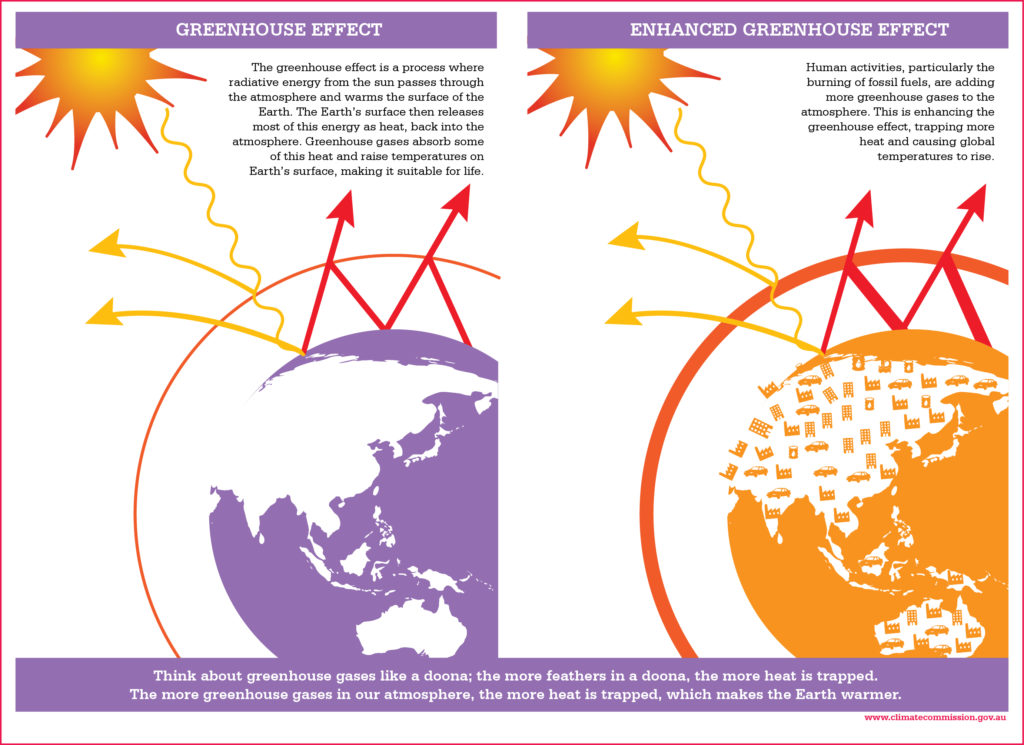
Natural greenhouse gases are water vapor, carbon dioxide, methane, ozone and nitrous oxide. These chemicals are an important part of the world’s natural cycles. They cycle between the atmosphere, the ocean, soils and rocks. Human activities have changed those cycles, meaning more greenhouse gases have entered the atmosphere, trapping more heat and leading to global warming and climate change.
Many human activities influence climate relevant cycles, but two of the most important are to do with carbon dioxide and methane. Fossil fuels contain carbon dioxide locked up millions of years ago, by bringing it to the surface and burning the fossil fuels human activity short circuits natural weathering and other cycles, creating one of the major sources of the excess carbon dioxide that is creating climate change.
Agriculture is also a major contributor to climate change, producing about a quarter of all current greenhouse gas emissions. These emissions come from the fuels used by farmers, but also because of emissions from rice paddies and livestock, which produce methane. A particularly powerful greenhouse gas, over a 20-year period methane is 80 times more potent at warming than carbon dioxide. On top of this, the removal of native vegetation, like forests, to create space for agriculture reduces the amount of carbon drawn out of the atmosphere and stored in trunks and roots as trees grow (known as sequestration).
As you can see there are many interconnected ways that human activities are influencing the biogeochemical cycles of Earth and thereby contributing to climate change.
Good sources of climate information are https://climate.nasa.gov/ and the new IPCC climate atlas https://interactive-atlas.ipcc.ch/
Two good Australian information sources are the CSIRO https://www.csiro.au/en/research/environmental-impacts/climate-change/Climate-change-QA and the Academy of Science https://www.science.org.au/education/immunisation-climate-change-genetic-modification/science-climate-change
You might also like to play with the simple climate model at en-Roads, explore options for reducing climate change https://en-roads.climateinteractive.org/scenario.html?v=21.10.0
Australia has seen plenty of climate related disasters in recent years. Most recently during the past year, floods in Qld, NSW, Vic, SA and Tasmania have been very damaging and costly to communities across the country.
Before the floods, we saw widespread bushfires during the summers of 2019/20 (mainland Australia) and 2018/19 (Tasmania), which motivated a Government investigation into how Australia can improve its National Natural Disaster Arrangements. The outcomes of that report states ‘Australia’s disaster outlook is alarming, with climate change exacerbating bushfires, extreme rainfall and flooding’.
‘Responding to climate disasters’ requires action in many ways.
Currently, almost all of the money spent on disasters is during the event (responding) or after (recovering). We should aim to be better prepared in the first instance, to minimise any damage happening at all.
Responding to the climate crisis needs us to both
Further reading:
Climate change can affect populations of animals in lots of ways.
Breeding – it can affect the way they breed every year. For example, Emperor penguins breed on the sea ice, in areas that are stable and don’t change from year to year. They lay their eggs on the ice and hatch the chicks and look after them until they are old enough to swim. But the areas of ice they breed on are being affected by climate change. Some areas of ice have shrunk, or broken up, destroying colonies that have bred in those areas for thousands of years. Some colonies are losing their special breeding areas and the number of chicks making it to adulthood is shrinking every year. Some breeding colonies no longer exist, because the sea ice they once used to raise their chicks is now gone. Over time this will slowly reduce the total number of Emperor penguins as there will be less new chicks coming into the population every year. Some colonies are ok and are not affected yet, but may be at risk in future.
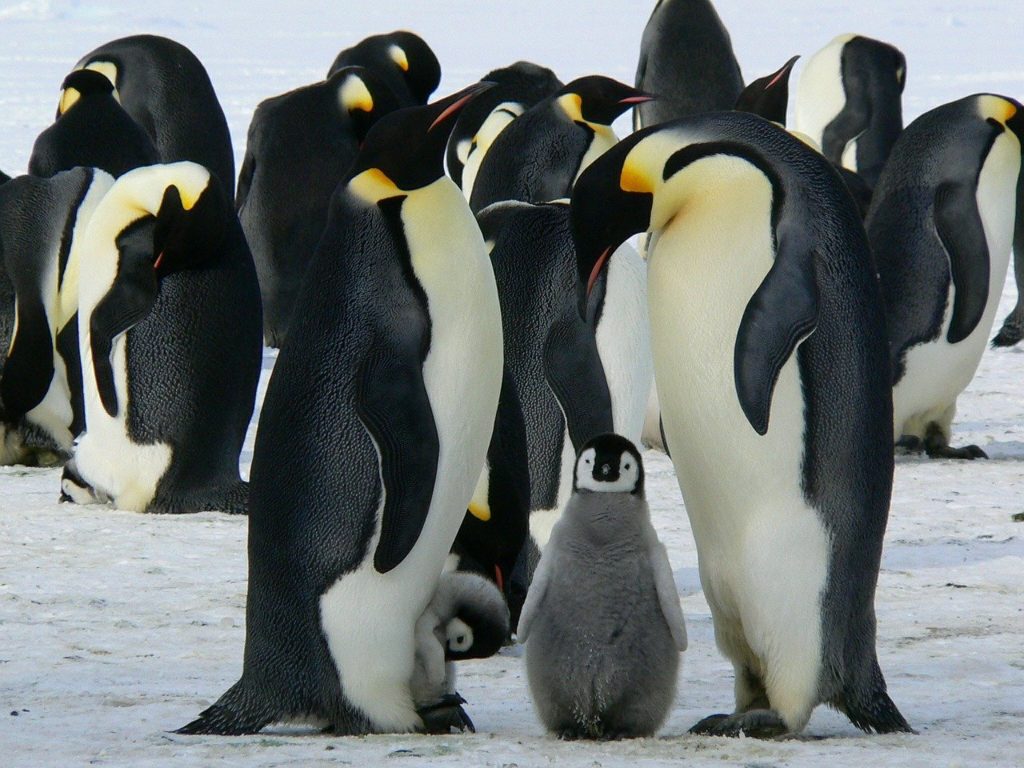
Competition – Some populations of animals may be affected by competition for space or food as climate change affects their habitats. Populations of animals that live on the sea floor in the dark areas under sea ice, where there is not enough light for seaweed to grow, may have to compete with seaweed for space as the amount of sea ice changes. With less sea ice there is more light that reaches the sea floor, which is good for seaweed but bad for the animals that live in these areas. Seaweed can grow very quickly once it is established, crowding out animals such as sponges and corals – outcompeting them for space. This could result in a loss of biodiversity in these areas as lots of animals populations are replaced by seaweed.
Ocean acidification – This is the process that occurs as more carbon dioxide is absorbed by seawater. It makes it slightly more acidic each year which can affect animals in lots of ways. One way is by affecting those animals which make shells out of calcium carbonate. Ocean acidification makes it harder for them to make their shell, and eventually it could mean their shells start to dissolve. This is already happening to a planktonic animal called a sea-butterfly, or pteropods. These beautiful little animals have very thin fragile shells. Climate change through ocean acidification is causing their shells to be smaller and weaker. This might mean they have to put more time and energy into making their shells, which could mean less energy for reproduction. It could eventually cause them to die before they can reproduce, meaning that their populations will shrink. This could have serious effects on the food web in Antarctic seas, as pteropods are important food for lots of other animals like fish, penguins and even whales.
This is a very practical question! I’ll suggest two things you can do straight away that are related: The first is to take care of your current school uniform so that when you are finished with it, someone else can use it. There are places that buy/sell/swap (e.g., Tasmanian School Uniforms Facebook Group, Gumtree, Uniformshop, etc. ).
There are a growing number of uniform suppliers that are sourcing sustainable materials. In this case, you’ll need to discuss this with your school and their supplier to transition to these suppliers. Some examples include ‘Hemp School Uniforms’ – which use natural and renewable materials and ‘Environmentally Friendly Eco Fabrics’ – which use recycled plastic.
This is an excellent question, and one of the questions most students want an answer to. You can be someone who takes climate action!
Each of us can act individually (on our own) and collectively (together with others) to act on climate. We know, from scientific evidence, that climate change cannot be stopped and is happening already – but it can be reduced and slowed down. People today and into the future (including you) can make changes and decisions that will greatly reduce climate change and its impacts.
Some of these decisions are happening on a systemic scale - they the really big changes we need to reduce emissions from industries and electricity generation.
For example, world leaders are meeting together at COP26 (which is the UN Climate Change Conference of the Parties) to discuss pathways to do this – in particular, to ensure that global temperature rises do not exceed 1.5 degrees, and how we can adapt to climate change impacts into the future. If we can manage to greatly reduce global greenhouse gas emissions (such as carbon dioxide) we can limit climate change.
You might wonder how young people can influence big changes like this? By using your voices! Young people are involved in many groups and movements such as the School Strikes for Climate that have already made a difference to the way world leaders think about climate action.
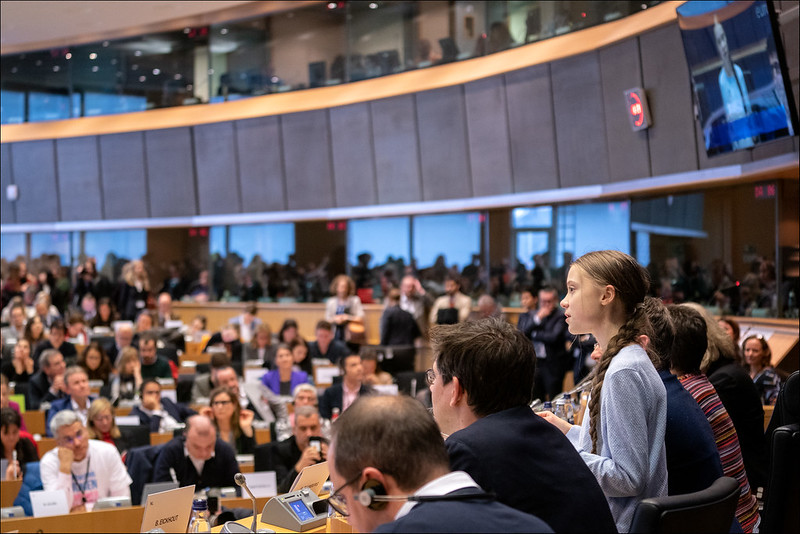
At a smaller scale, all of us can do something to make positive changes and have an impact on tackling climate change. Some people can do more and less than others, and that is OK - it’s great actually because lots of small changes can lead to big impact. In everyday life, there’s lot that you might be able to do, for example:
There are a lot more ideas you can check out on our 'What can I do?' page.
Great question, one that a lot of experts are working on every day! While the answer to this question differs greatly between each of those different groups, a good place to start is break down climate goals into two main categories: mitigation and adaptation. Mitigations are the actions you take to reduce contributions to climate change while adaptations are the actions you take to be better prepared for the negative impacts caused by climate change. Even those these are typically separated when we write plans and policies, it is not either/or, but both at the same time. As for your school, a local business, or your wider community some of these actions are more achievable than others.
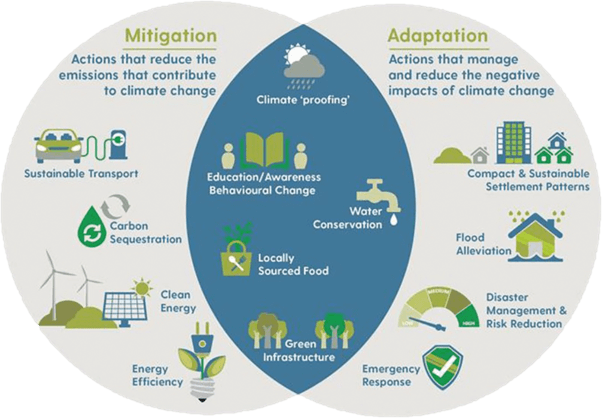
The most important thing you can do is to become informed, like by reading and watching all the answers on Curious Climate! Do you know how much water and electricity your school uses? Has your school considered adding solar panels or purchasing electric school buses? Do you know where the food in your cafeteria comes from or if your school is at risk of floods or bushfires? Knowing the answers to these questions is the first step in taking action to address climate change. Many businesses have already taken this step by identifying where they can and can’t take action to reduce their impact and if they are climate “proofed”, meaning are they prepared either physically or financially for extreme weather events.
For communities, like many of those across Tasmania and Australia, there have been plenty of efforts to research and write both climate change mitigation and climate change adaptation plans. The plans include actions like putting in more electric car charging stations, replacing lightbulbs with more energy efficient LEDs, creating climate change outreach programs, and developing vast disaster management plans so that you, your family, your school, and all the local businesses are prepared for floods, bushfires, and other disasters. The biggest challenge for communities is that there are not enough resources to cover every action they want to take. By working with your school to both mitigate and adapt to climate change, you can help alleviate their burden and help everyone to meet their climate goals.
In the last few years, Tasmania has made quite a bit of progress towards protecting native forests, but there is still a lot of space for us to do better.
The first step to protecting nature, whether on land or on sea is to identify what the threats are. For Tasmanian forests some of the key threats today are logging and clear-cutting and the effects of warmer temperatures. These threats feed into each other. When trees are cut down carbon dioxide is released into the atmosphere and less is taken out. When this happens, the global temperature rises. Not only this, trees and other plant species work together to create their ideal growing conditions. When trees are lost from an area it also means there is, for instance, less shade to help the remaining plants keep each other cool. Like us, all species have a limit to how much of heat or cold they can withstand; in the same way that we find it hard to do anything when it is too hot, trees are also less able to do the things that they need to do to live. Recently, there was a lot of research, including one done in Huon Valley during a heatwave, that found that trees are less able to feed themselves through photosynthesis when the temperature is too high for them. When it’s too hot, trees also emit more Carbon dioxide into the air, this is because, as with all species that breathe (this includes trees!) they respire more when it is hot. So, in more ways than one, less trees means more heat and, unfortunately more heat also means more fire danger.
It is important for us to know and understand that fire is a natural part of the life cycle of many forest plants in Australia. Fires help some plant seeds to germinate, it helps clear the forest floor allowing sunlight to reach the seeds on the ground. It kills off weeds and insects that might be harming the surrounding plants, and it even helps add nutrients that plants need to grow into the soil. So, fire is not bad, fire is needed for forests to continue growing, but all things in nature (us included) needs delicate balance. Too little or too much of something can impact your health and growth, for instance, you need carbohydrates and proteins in your diet to be healthy, but too much of either will lead to health issues. In recent years, bushfires have been burning too hot and for too long for forests. Instead of helping seeds grow and clearing away things that are harming them, these fires, often made worse by climate change, is burning the forests away.
So, what can we do to reduce these threats and help forests thrive? We need to take into account all those things that our forests need in order to grow, and make sure that management plans for these forests are correctly and efficiently addressing these needs. Aboriginal knowledge and scientific research in recent years, tell us a lot about what conditions Tasmania’s plants grow best in. It is important that we push for forest management that synthesizes these knowledge systems. With the changing climate, we need to think about how we can make our forests more resilient heat and other changing conditions too. So, forest managers will need to carefully nurture and cultivate forests by working with the environment in the same way that Aboriginal communities have done for centuries past. For instance, seeds of species collected from warmer forest areas can be sown to grow trees that are better able to handle warmer temperatures. There is always variation even within a single population – my brother, for example, is much better at handling cold weather than I am! Research can help identify individual trees that can withstand heat better and we can grow these in forests to help the secure the future of the forest. This is something that researchers are trying right now to help bring back Giant Kelp forests in eastern Tasmania.
As part of forest management, we also need improved fire management in Tasmania. This means working towards reducing large bushfires while also applying planned fires to areas that need regular burning. This requires quite a lot of careful planning that considers species that are sensitive to fire, species that need fire, threatened species and habitats that need protection, safety conditions, etc. Forest management also needs to reduce other threats, such as logging and pollution. This is quite a lot to think about and plan for, but it is entirely doable by working together with the right sources of information, the right tools and with a united goal. In other words, we know how we can protect forests better and what is needed to do this… but more resources, such as funding for more research and planning, and support is needed if we are to properly conserve our forests.
By advocating for and asking your councils and political leaders for better, more sustainable forest management, we can increase the amount of funding and resources that governments put towards protecting and managing them. In Australia, there is always space to be involved in decisions made by governing bodies, you can find out what your local council is doing through their website, or simply by giving them a call. Be involved where you can and ask those around you to do the same. Your voice always counts! We can of course also contribute to protecting our forests through everyday things. The best way to reduce deforestation and logging, not just in Tasmania but globally, is to reduce demand for it. Re-using, recycling, upcycling, and reducing consumption of things like paper would reduce the need for trees to be cut down at all.
All things on earth only work when working together, whether it’s a colony of ants, a forest system, or a nation of people – it is the simplest law of nature. Protecting one system means to protect another. Protecting forests will benefit us all. All things considered, to better protect Tasmania’s forests, it would truly be enough simply to remind ourselves and everyone around us of this!
In the last 2,000 years the human population has increased by 7,510,000,000 (more than seven and a half billion) with the last 100 years (since 1900) seeing an increase of more than six billion people (Figure 1). Rates are starting to slow, but there will still be more than a billion more people in the next decade. Earth systems have limits, many of which are already being stressed due in no small part to an increasing global population. However, increasing population is only one part of the puzzle, we also need to look at consumption.
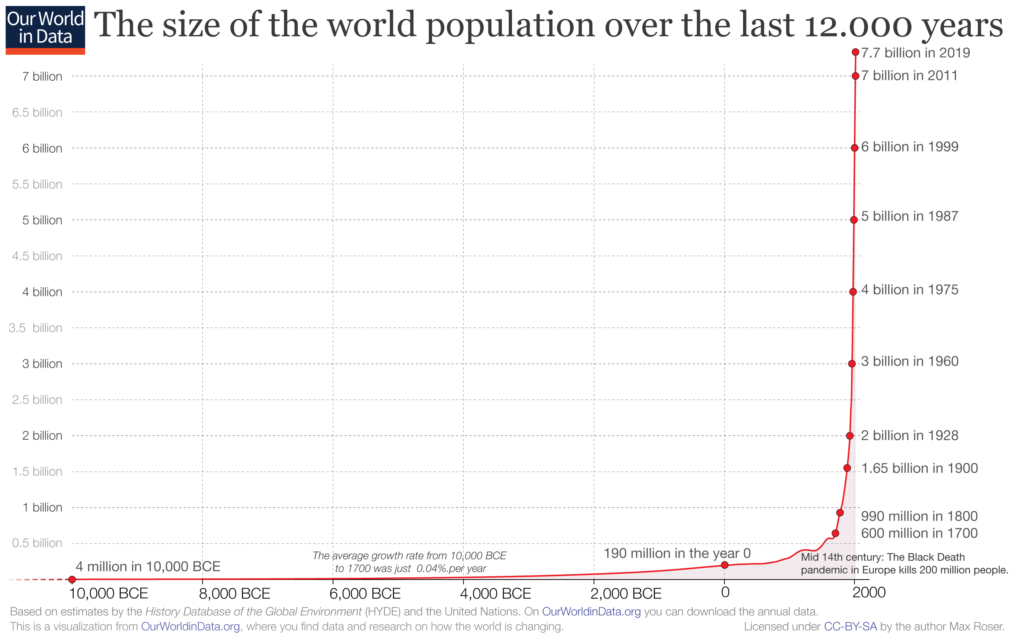
One way to think about consumption is to consider what you ate today, how often you travelled in a car, and how much stuff you bought. Monitor that every day for an entire year, add it all up, and you get your personal rate of consumption. If you do that for everyone in Australia and divide it by the country’s population, we can get an average consumption rate, also called consumption per capita. Now here is where things get tricky. If all 7.7 billion people on the planet consumed resources at the same rate as Australia, we would need almost five Earths worth of resources. Fortunately, not every country consumes as much as we do, but most countries consume far above the planetary limits, despite all our advances in agriculture, new energy saving technologies, and changes in lifestyles. And collectively, the whole world is already consuming 1.7 Earths, which would only get worse with more people on the planet.
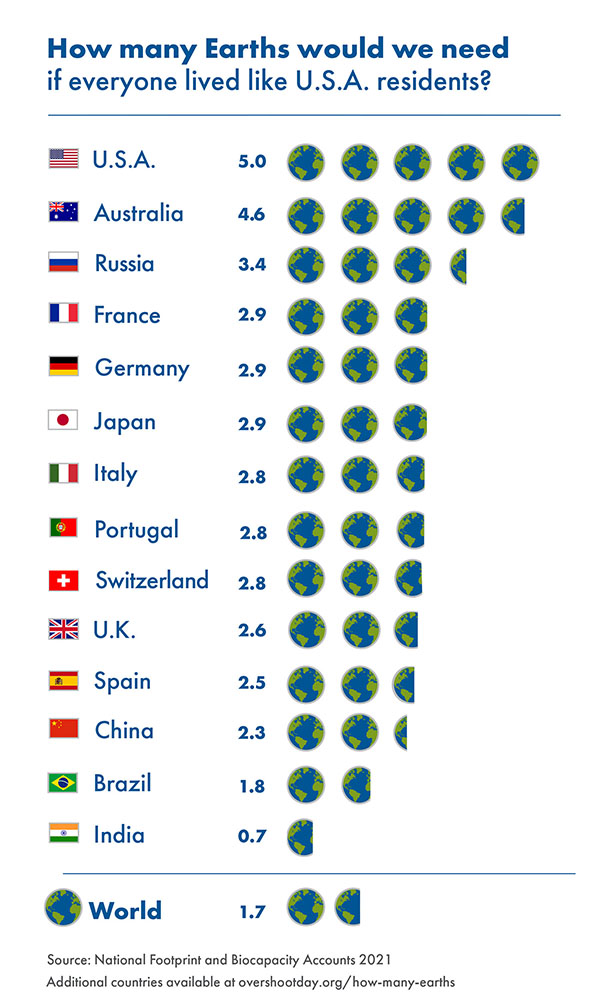
So with the global population still increasing and our consumption rates being wholly unsustainable, what can we do? China, in an attempt to reduce its population, implemented the One Child Policy from 1979-2015, which, while reducing the population, has resulted in a lot of unintended consequences that will cause serious problems in the coming years. Alternatively, countries like Japan, New Zealand, and other high-income countries are having fewer children born every year. But that transition can take a long time and usually requires increasing rates of consumption before getting there. One of the most successful ways to reduce populations is investing resources into female empowerment and pro-active family planning. For example, South Korea saw a major drop in the number of children being born between 1960 and 2015, due in large part to improved women’s rights. While those investments are the most ethical way to reduce the Earth’s population, we need to spend even more time working on ways to reduce our massive consumption rates.
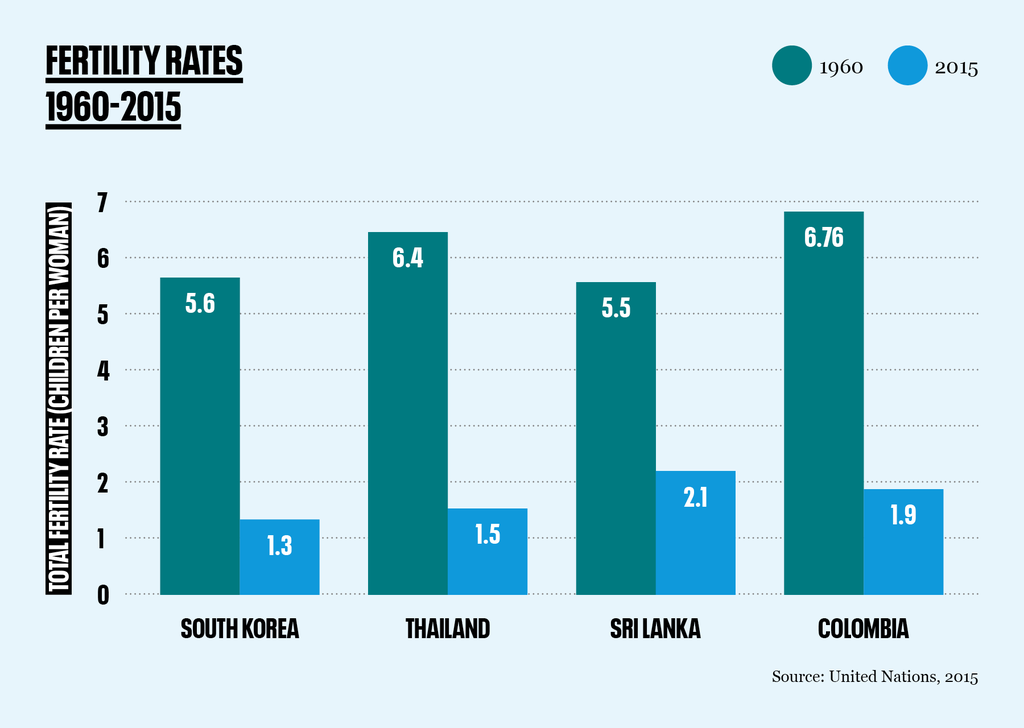
This is such a great question! Taking climate action is really important for stopping or reducing the climate change impacts that we might face. The more people who take action, the more we can collectively curb these impacts.
To understand how to get more people to take action, we need to think of why they might not be taking action already. One reason might be that people don’t know how to take action or where to find information to learn about taking action. In this case, we know that climate conversations are really helpful. Talking to your friends, teachers, neighbours, parents, and other family members about what climate change is, what it means for the world, and what each of us can do to take action, can be a catalyst for people to make changes they might not have done otherwise. In fact, some recent research shows that children build climate change concern among their parents and are key to encouraging parents to take action. You can have your own climate conversations with your parents or other people you know, telling them why climate change is such a big issue and what they, you, and we all can do to take action and make a difference. Check out the Curious Climate Schools website for lots of suggestions on small to bigger ways we can all take climate action.
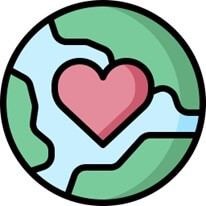
Another reason that people might not already be taking action, is that they are overwhelmed by the climate emergency. They might be sad or angry about climate change and not think that their actions can make a difference. But these individual actions can and do make a difference. We can ask people: Does climate change make you angry, scared, worried? And let them articulate their feelings. We can tell them that this is okay, we all have feelings about climate change and it’s useful to talk about them with our classmates, friends, and families. Talking about climate change can help us all to work together to imagine and create more ways to address climate problems.
For example, to reduce greenhouse gas emissions we can think of ways we can act
- individually: such as recycling or reducing our food waste
- collectively: such as using our voices in climate strikes, or demanding that classrooms and schools make changes too,
- at systematic levels (think big scale): by talking to local politicians about what they are and can be doing to make climate action happen at local to State levels, or by encouraging parents and adults to vote for parties who take climate action into real consideration.
Taking action can help people realise that there is something they can do to make a difference and can help with their feelings of overwhelm and climate worry or anger. Keep talking about climate change to those around you, every conversation can make a difference and encourage people to take actions, big and small 😊
More and more students want to be part of the solution to reduce the impact of climate change. While some have already been active in this space, some might not have engaged yet but might be more inclined with the right approach. Though climate change is serious and taking action is urgent, this can be quite overwhelming to some and create much anxiety. Others may not think they can make a difference. Still others might not understand the complexities of climate change, or even understand how their everyday activities impact the climate.
So meet people where they are. Everyone will have a different starting place. It might involve educating other students and raising awareness. Its important to use a positive and pro-active approach. Have options that students can enjoy, easily participate in, and that connect small local actions to the larger global issues. Here are some examples of local actions that can reduce climate omissions in Tasmania.
Remember that changing habits takes time. It’s not just knowing what is best, but making it easy to do, within your control, and supported by others around you. Be positive and think about the small and large actions you can do and celebrate victories.
One more thing, you may wish to organise activities where students (re)imagine what a sustainable world/city/community would look like? Will there be more innovative and renewable energy sources, greenspaces, connected communities, etc.
Prof. Jason Byrne at UTAS shared some great ideas in response to the question: What do you think climate change will alter about the world in my lifetime, and what can I do about it? https://curiousclimate.org.au/school_themes/taking-action/
For activities to support education and awareness, have a look at these sites:
Primary school level:
Climate Council Climate Change Animation
Connect with Sustainability Learning Centre in Hobart
Connect with Education for Sutainability Tasmania
Secondary school level:
Compare your ecological footprint
Connect with others in the AYCC
Sources:
2022 Tasmania Greenhouse Gas Emissions Report
The best way to hold people accountable for their carbon footprint is called ‘carbon pricing,’ which means putting a price on carbon dioxide emissions, so that it becomes more expensive for companies to pollute, and for people to buy products that are polluting.
This corresponds to what we call ‘the polluter-pay principle.’ It means that the person (or company) who is responsible for the pollution must pay for the damage it causes. For example, if companies paid a tax on the amount of carbon dioxide they use, their business would become more expensive to run, and this would encourage the company to invest in alternative sources of energy (wind and solar energy).
A variation of this principle is ‘the user-pay principle.’ It is the idea that the consumer, who benefits from the pollution, should pay for the damage. For example, if products with a high carbon footprint were more expensive, people would want to buy less of them, and use alternatives.